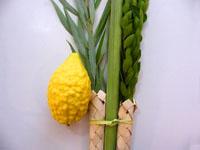Lulav
From Halachipedia
Revision as of 20:46, 13 September 2013 by YitzchakSultan (talk | contribs)
The obligation to take a lulav on succot comes from the pasuk הדר כפות תמרים וענף עץ עבות וערבי נחל And you shall take on the first day the fruit of goodly trees, branches of palm-trees, and boughs of thick trees, and willows of the brook. [1]
Acquiring the Lulav
- One should buy a lulav with a hechsher (certification that it is from a reliable source) in order to be sure that it came from a date palm tree and not a Canary palm.[2]
- One can acquire a Lulav from one's friend as a gift even if there's a condition that says one must return it afterwards, as long as one actually does return it afterwards.[3]
Split Tip
Crooked Spine
Sources
- ↑ Vayikra 23:40 and Gemara Sukkah 34b
- ↑ Rav Moshe Feinstein (Igrot Moshe O.C. 4:123) holds that a branch of a Canary palm tree, which does not produce edible dates, is not considered a lulav. Rav Shlomo Zalman Auerbach (cited in Halichot Shlomo 10:9), however, argues that the date palm and Canary palm are of the same species. Rav Hershel Schachter (“Halachos of Daled Minim,” min. 15) favors the former approach. The Halachos of the Four Species (p. 100) details how to distinguish a Canary palm branch from the regular date palm branch; one indication is that the spine of the Canary palm is very flexible. For more sources about a Canary Lulav see: Tzitz Eliezer 8:22, Kashrut Arbat HaMinim p. 170, and Yachava Daat 1:67. See Sefer Sukkat David (p. 52) who writes that if a Lulav came from a Lulav tree which does not grow fruits it is acceptable for the mitzvah of Lulav.
- ↑ S"A 558:4 writes that one can acquire the lulav through a gift with a condition that it must be return afterwards if one actually does return it afterwards. Mishna Brurah 558:12 explains that when one gives the Lulav to one's friend as a gift it is a complete acquisition and returning it later is only a completion of a condition that is imposed upon the gift. See, however, S"A 448:3.
